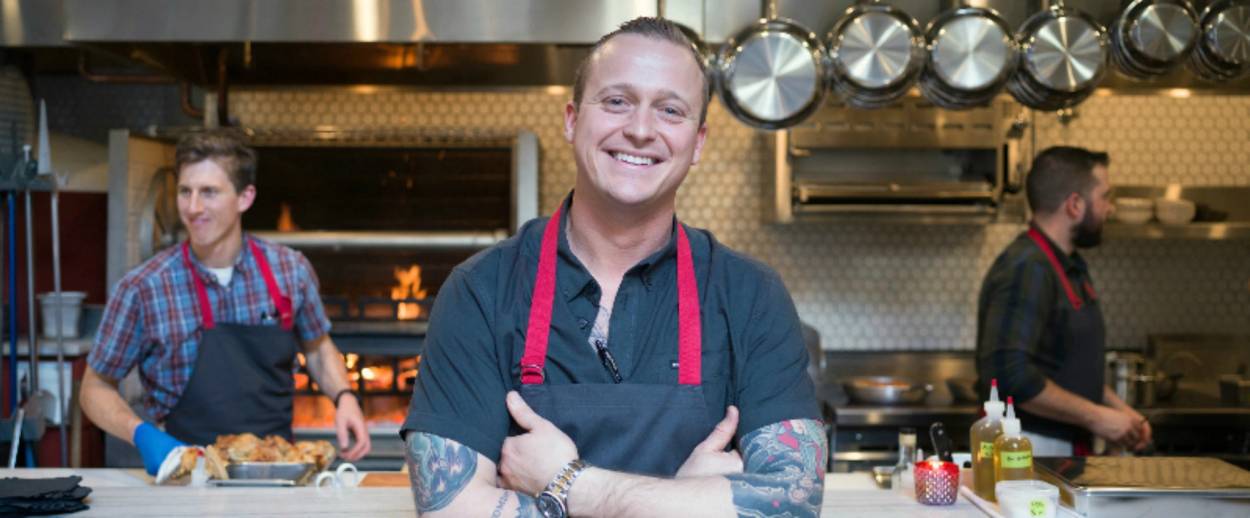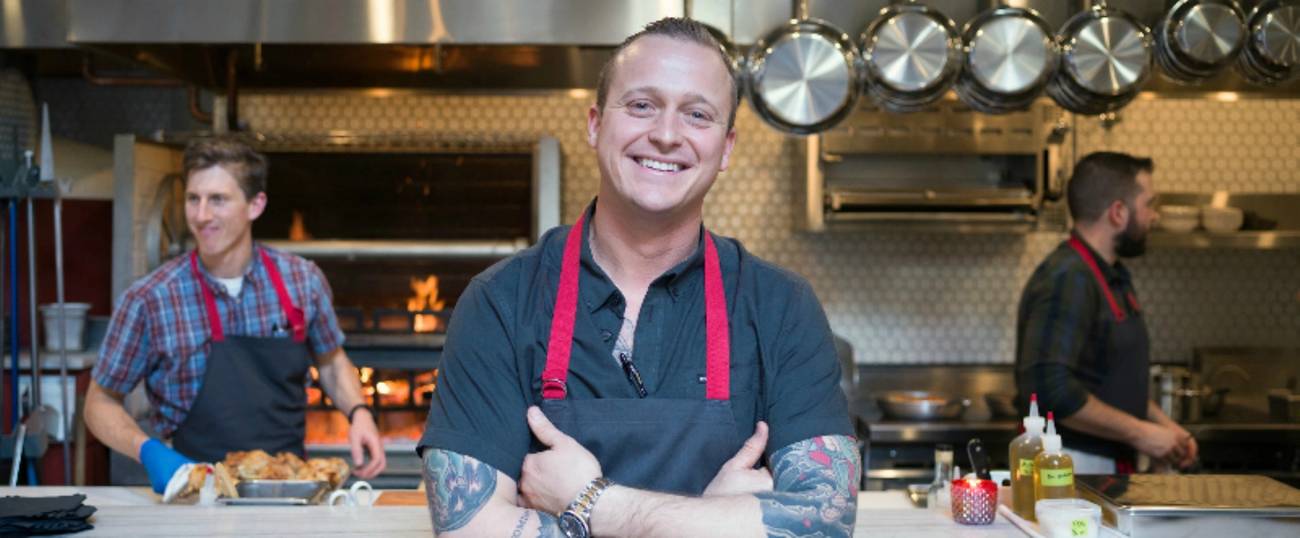Even in such a food-obsessed city as San Francisco, it’s rare that a restaurant gets the kind of buzz that Che Fico did, before it even opened.
Even more rare: that such a highly anticipated and Instagram-able restaurant—which happens to be Italian—has a dedicated section on the menu for Jewish cuisine.
And what makes this even more newsworthy: Che Fico has a first-generation American chef at the helm, but not from Italy; Chef David Nayfeld’s parents are Jewish immigrants from Belarus.
While he can’t know for sure, Nayfeld believes he is the only chef in the country with a special section devoted to dishes inspired by Roman-Jewish cuisine.
The “Cucina Ebraica” section appears on the menu right beneath the “Antipasti,” and the servers explain that these are dishes near and dear to chef’s heart.
Che (pronounced Kay) Fico means “What a fig,” in Italian, which is slang for “How cool.”
Giving his restaurant such a strong Jewish identity is deliberate, says Nayfeld, 34. “We’ve been made into scapegoats so many times, and hearing ‘Jews will not replace us,’ and weird shit like that recently,” he said, is one motivating factor.
But then again, he’s always been proud of who he is. Nayfeld grew up in Alameda, in the San Francisco Bay Area, adjacent to Oakland, the first in his family to be born here.
While not religious at all, he said, “Jewish culture has been a huge factor in my life,” he said. “A lot of my peers with refugee parents tried to assimilate, but I was always loud and proud about who I am, so I wanted to find my identity within this cuisine.”
But there’s another reason as well.
Nayfeld traveled extensively, eating his way through Italy in the name of research, and was drawn to the Jewish ghettos; not being aware of their existence in Italy long before World War II.
“I thought, ‘I have to know about this and understand it,’ but I’m not a historian,” he said. “As a cook, the first way you learn about history is through the food.”
The Roman-Jewish community is the oldest in Western Europe and dates back to 161 B.C.E. Jews fleeing the Spanish Inquisition, and then, much later, Libya, an Italian colony, each brought their own Sephardic influences to Jewish cuisine there.
Nayfeld was struck by how such dishes as Carciofi alla Giudia, or fried artichokes, and suppli—an oblong deep-fried mixture of rice, cheese and tomato, a cousin of the arancini—were so ubiquitous on Roman menus as to be held up as emblematic of Roman cuisine, but with no mention of their Jewish roots.
“It was awesome, yet I also felt sad that they were not being called out as to from where they originated,” he said.
Not at Che Fico. The Jewish section is a result of “my searching for my connection to this cuisine and culture. Being Jewish in a very interesting and strange way, you feel connected to every other Jew in the world,” he says. “There’s this ‘we’re all in this together’ type of feeling.”
Since opening in late March, the restaurant has been Instagrammed by Gwyneth Paltrow and Anderson Cooper. A recent Eater S.F. headline declared “Che Fico is S.F.’s Most Exciting New Place to Eat Right Now,” and noted that reservations are booked over a month out, with walk-in wait times up to four hours.
The reason for the hype surrounding the restaurant is because Nayfeld, as senior sous chef, helped take New York City’s Eleven Madison Park from a new restaurant to one with three Michelin stars and four stars (the highest possible ranking) from The New York Times. He met Che Fico’s pastry chef, Angela Pinkerton, there, as well. (The two of them are co-owners of a downstairs café named after Pinkerton’s grandmother, Theorita, opening soon, with a third partner, Matt Brewer.)
“It was a very different restaurant at the time I started,” said Nayfeld. “It was Daniel Humm and a crew of young chefs working super hard to do what they all deemed to be the best and coolest and most creative and delicious food possible.”
Nayfeld’s ascent through the culinary world can be seen as a typical immigrant’s story.
Nayfeld’s mother, Galina, is a chiropractor (her office is about a mile from the restaurant, making it easy for her to stop in for dinner after work—that is, if she can get a reservation), and his father Mark sells medical equipment.
Nayfeld was a latchkey kid—Galina cleaned houses while attending chiropractic school—and David and his brother were at home with either grandmother, or a nanny; these women came from Uzbekistan, Ukraine, Moscow, or, if they were his own grandmothers, from Belarus, so someone was always cooking Russian (both Jewish and non-Jewish) food at home.
A picky eater as a child, he began cooking for himself. At age 13, he started working at a local cafe, mostly because he wanted his own money without having to ask for it.
When he—not the greatest student—became fixated on New York, and announced he wanted to attend NYU, his father scoffed.
“If I could have told him there’s something at NYU that I was really good at, he would have sold the house for me to do it,” said Nayfeld, “But for me to go there on a whim, for him, that sounded stupid.”
But after his mother expressed her initial hesitation in his not getting a college degree, she accompanied him across the country to visit the Culinary Institute of America’s Hyde Park campus. He’s felt nothing but support from them ever since, he added.
After graduating from the C.I.A., he worked primarily in fine-dining. In addition to Eleven Madison Park, his resume includes time at San Francisco’s Aqua, New York’s Cru—it’s there where he fell in love with making pizza and pasta—and Las Vegas’ Joël Robuchon.
“You’re chasing the stars and the legends. If you want to be the best at something, you need to go learn from the best in the world,” he said. “Once I learned that Robuchon was considered the best chef in world, I wanted to work for him.”
When Nayfeld left New York, it was to return home; he wanted to be close to his family. At first, he thought about opening his own Bay Area spin of Eleven Madison Park. But that changed pretty quickly once he was away.
“If you’re going to be cooking something every day, it should be something you want to be craving when you look at it,” he said. “When you see the food coming out of the kitchen, you should think ‘I wish I could eat that right now but I have to send it to a guest.”
And when he thought about which cuisine that was, in his mind, it turned out to be Italian.
But all that attention to detail that Nayfeld learned in the fine-dining world has not gone to naught. According to some reports, he experimented with 600 different variations of pizza dough before landing on the slightly sourdough version he ended up with.
Outside of the Jewish section of the menu, one will find pizza and pastas, both traditional and not, as well as wood fired chicken, pork belly and slow-roasted lamb, served family style.
While I was fully expecting to find the deep-fried artichokes, as they are perhaps the best-known Roman-Jewish dish, Nayfeld explained he hadn’t yet perfected them.
San Francisco-based chef, scholar and author Joyce Goldstein, explained that American artichokes do not lend themselves as easily to that dish.
Goldstein, author of the 1998 book Cucina Ebraica: Flavors of the Italian Jewish Kitchen, and more recently, The New Mediterranean Jewish Table, said that hallmarks of Roman-Jewish cuisine include artichokes and more artichokes, vegetables like zucchini preserved in vinegar, and lots of fried foods, like the suppli.
Nayfeld is adhering to tradition with some dishes, but with others, he is most certainly not. For example, take his grilled chopped duck liver with wood-fired matzo. A play on traditional Ashkenazi chopped liver, he serves it with an onion marmalatta and garnishes it with translucent slices of purple daikon radish. And there’s an unlikely ingredient in the liver.
“There’s a reduction of Concord grape juice and Manischewitz,” he says. “A little bit of sweetness offsets the iron taste in the grilled offal; I find that for my taste, the mixture has a bit of familiar flavor, and brings me back to my childhood.”
We also tried the chicken heart and gizzard salad that our server told us was chef’s favorite dish on the menu, and the suppli. Also on the Cucina Ebraica opening menu were a caponata—an eggplant spread with roasted peppers and raisins and walnuts—and beef tongue with salsa verde and crispy capers, based on a sandwich he had in Rome.
“It’s fun to see how my Ashkenazi culture lends itself to what is more of a Sephardic cuisine,” he said. “Some of it comes from my wondering what Jewish cuisine would be if it was a region in Italy.”
With the chicken hearts and gizzards salad, he’s reimagined it as a modern Olivier salad, which is a classic Russian dish featuring potatoes, peas and other chopped vegetables in a mayonnaise-based dressing; his features aioli instead.
Reaction to the “Cucina Ebraica” menu so far has been positive.
“Jews are excited to see their food represented,” he said. “Others who are more foodies like to see items that are unique and not found other places.”

